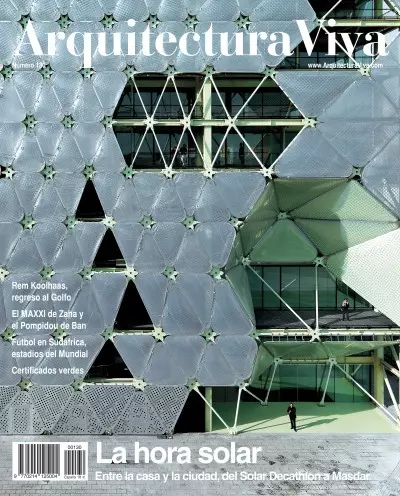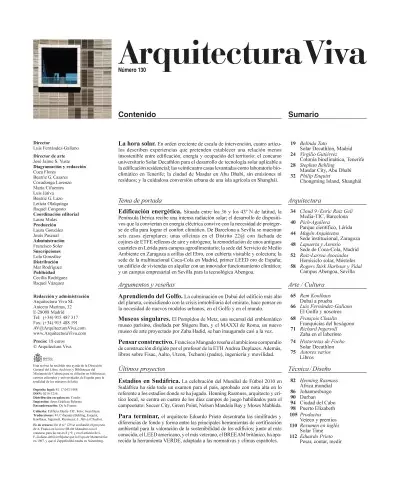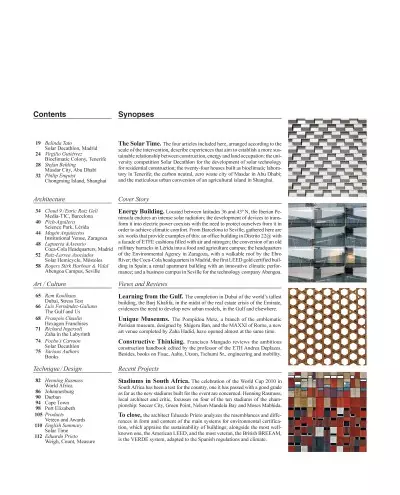Synopses
The Solar Time. The four articles included here, arranged according to the scale of the intervention, describe experiences that aim to establish a more sustainable relationship between construction, energy and land occupation: the university competition Solar Decathlon for the development of solar technology for residential construction; the twenty-four houses built as bioclimatic laboratory in Tenerife; the carbon neutral, zero waste city of Masdar in Abu Dhabi; and the meticulous urban conversion of an agricultural island in Shanghai.
Contents
Belinda Tato
Solar Decathlon, Madrid
Virgilio Gutiérrez
Bioclimatic Colony, Tenerife
Stefan Behling
Masdar City, Abu Dhabi
Philip Enquist
Chongming Island, Shanghai
Energy Building. Located between latitudes 36 and 43º N, the Iberian Peninsula endures an intense solar radiation; the development of devices to transform it into electric power coexists with the need to protect ourselves from it in order to achieve climatic comfort. From Barcelona to Seville, gathered here are six works that provide examples of this: an office building in Distrito 22@ with a facade of ETFE?cushions filled with air and nitrogen; the conversion of an old military barracks in Lérida into a food and agriculture campus; the headquarters of the Environmental Agency in Zaragoza, with a walkable roof by the Ebro?River; the Coca-Cola headquarters in Madrid, the first LEED gold certified building in?Spain;?a rental apartment building with an innovative climatic performance; and a business campus in Seville for the technology company Abengoa.
Cloud 9/Enric Ruiz Geli
Media-TIC, Barcelona
Pich-Aguilera
Science Park, Lérida
Magén Arquitectos
Institutional Venue, Zaragoza
Lapuerta &Asensio
Coca-Cola Headquarters, Madrid
Ruiz-Larrea Asociados
Solar Hemicycle, Móstoles
Rogers Stirk Harbour & Vidal
Abengoa Campus, Seville
Views and Reviews
Learning from the Gulf. The completion in?Dubai of the world’s tallest building, the Burj Khalifa, in the midst of the real estate crisis of the Emirate, evidences the need to develop new urban models, in the Gulf and elsewhere.
Art / Culture
Rem Koolhaas
Dubai, Stress Test
Luis Fernández-Galiano
The Gulf and Us
Unique Museums. The Pompidou Metz, a branch of the emblematic Parisian museum, designed by Shigeru Ban, and the MAXXI of Rome, a new art venue completed by Zaha Hadid, have opened almost at the same time.
François Chaslin
Hexagon Franchises
Richard Ingersoll
Zaha in the Labyrinth
Constructive Thinking. Francisco Mangado reviews the ambitious construction handbook edited by the professor of the ETH Andrea Deplazes. Besides, books on Fisac, Aalto, Utzon, Tschumi Sr., engineering and mobility.
Focho’s Cartoon
Solar Decathlon
Various Authors
BooksRecent Projects
Stadiums in South Africa. The celebration of the World Cup 2010 in South Africa has been a test for the country, one it has passed with a good grade as far as the new stadiums built for the event are concerned. Henning Rasmuss, local architect and critic, focusses on four of the ten stadiums of the championship: Soccer City, Green Point, Nelson Mandela Bay and Moses Mabhida.
Technique / Style
Henning Rasmuss
World Africa
Johannesburg
Durban
Cape Town
Port Elizabeth
To close, the architect Eduardo Prieto analyzes the resemblances and differences in form and content of the main systems for environmental certification, which appraise the sustainability of buildings; alongside the most well-known one, the American LEED, and the most veteran, the British BREEAM, is the VERDE?system, adapted to the Spanish regulations and climate.
Products
Veteco and Awards
English Summary
Solar Time
Eduardo Prieto
Weigh, Count, Measure
Luis Fernández-Galiano
The Solar Time
Solar time is not the time of the solar house: it is the time of the slow city. Indeed, solar houses as those gathered in Madrid for the first Solar Decathlon in Europe are useful platforms for innovation, and fertile grounds for technological competition among universities, stimulating among young architects and engineers the entrepreneurial spirit and the interest in scientific experiment, backed by the strict control of results. However, the fruits of this collective effort should not be used to marginally improve the energy behavior of the single-family houses in the sprawling city generated by the automobile, but to improve the already very efficient compact city, which can afford to be slow when its scale does not demand yielding to the insomniac flow of traffic. The solar house is not a laboratory for the house of the future, but a testing ground for cities without detached houses, and new experiences of urban sustainability all speak the language of density.
After all, the thermodynamic virtue of architecture lies not so much in the many mechanisms, panels and pipes that fill solar or ecological constructions, nor in the planted roofs and heavy walls of organic or green building, which mostly privileges thermal inertia over energy collection: it must be found rather in general architectural matters of surface/volume and solid/glazed ratios, insulation, orientation and natural light, aside from the essential issue of the energy costs of construction and demolition of urban infrastructures and buildings, with the subsequent impact on the use of scarce resources and in climate change through the emission of carbon dioxide. Self-sufficient or sustainable architecture is in fact a mirage, but it is also an objective we ought to approach, be it through complex codes, or through the rediscovery of rules and principles we judge timeless, but that correspond simply to historical periods of energy scarcity.
After the devastation caused by earthquakes or tsunamis, the flight chaos provoked by an Icelandic volcano is undoubtedly a minor issue, but which has made Europeans aware of our vulnerability to the violence of nature, which we can only pretend to control with technique. These ashes in the air blend with the oil spills in the Gulf of Mexico waters, with financial turbulences made worse by the algorithmic trading of fast and blind machines, and with the first hesitant steps of artificial life to trace an uncertain panorama in which we do not know if solar time will be told by the same mechanical clock that marked the hours in monasteries to engender capitalism or by a simple sundial, as fitting for a classical vanitas as a clepsydra or an hourglass, and probably closer to architecture due to its geometrical condition: the clockmaker of this fleeting time should perhaps learn gnomonics, and thus celebrate the impassive slowness of life, transitory, fragile and tenacious.








